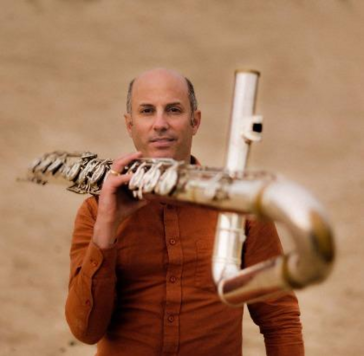Functional Magnetic Resonance Imaging (fMRI) was used to study the activation of cerebral motor networks during auditory perception of music in professional keyboard musicians (n=12). The activation paradigm implied that subjects listened to two-part polyphonic music, while either critically appraising the performance or imagining they were performing themselves. Two-part polyphonic audition and bimanual motor imagery circumvented a hemisphere bias associated with the convention of playing the melody with the right hand. Both tasks activated ventral premotor and auditory cortices, bilaterally, and the right anterior parietal cortex, when contrasted to 12 musically unskilled controls. Although left ventral premotor activation was increased during imagery (compared to judgment), bilateral dorsal premotor and right posterior-superior parietal activations were quite unique to motor imagery. The latter suggests that musicians not only recruited their manual motor repertoire but also performed a spatial transformation from the vertically perceived pitch axis (high and low sound) to the horizontal axis of the keyboard. Imagery-specific activations in controls were seen in left dorsal parietal-premotor and supplementary motor cortices. Although these activations were less strong compared to musicians, this overlapping distribution indicated the recruitment of a general 'mirror-neuron' circuitry. These two levels of sensori-motor transformations point towards common principles by which the brain organizes audition-driven music performance and visually guided task performance.
DOCUMENT

Paperbijdrage conferentie EARLI SIG 14, 11-14 september 2018, Genève Although professional performance at the workplace is essential in VET, little is known about what educators do when assessing students’ performance. This study aims to explore how workplace educators inform their judgements of students’ performance by looking at strategies and potentially influencing factors.
DOCUMENT

Vocational education aims at preparing students for their future as professionals; thus, students are often required to undergo a form of on-the-job learning. Assessment of professional performance during on-the-job learning is not based on single observations, but on prolonged participation at the workplace culminating in judgement by a workplace educator. However, little is known about how educators reach a judgement. This paper, therefore, aims at exploring how educators inform their judgements about students’ professional performance. We consider the workplace to be a participatory learning environment, which entails that judgement about professional performance should be made in relation to the community students participated in and that the educator from that community has a central role. Our study takes an explorative approach based on interviews and uses template analysis to generate insight. Findings revealed that educators use multiple strategies to gather and process information about students to inform their judgement. Findings also showed that assessment starts at the first meeting, when the educator forms a first impression of the student and judges whether or not the student is suitable for the job. Educators at the workplace also showed that they are aware of the context in which they form their judgement.
LINK
Students in Higher Music Education (HME) are not facilitated to develop both their artistic and academic musical competences. Conservatoires (professional education, or ‘HBO’) traditionally foster the development of musical craftsmanship, while university musicology departments (academic education, or ‘WO’) promote broader perspectives on music’s place in society. All the while, music professionals are increasingly required to combine musical and scholarly knowledge. Indeed, musicianship is more than performance, and musicology more than reflection—a robust musical practice requires people who are versed in both domains. It’s time our education mirrors this blended profession. This proposal entails collaborative projects between a conservatory and a university in two cities where musical performance and musicology equally thrive: Amsterdam (Conservatory and University of Amsterdam) and Utrecht (HKU Utrechts Conservatorium and Utrecht University). Each project will pilot a joint program of study, combining existing modules with newly developed ones. The feasibility of joint degrees will be explored: a combined bachelor’s degree in Amsterdam; and a combined master’s degree in Utrecht. The full innovation process will be translated to a transferable infrastructural model. For 125 students it will fuse praxis-based musical knowledge and skills, practice-led research and academic training. Beyond this, the partners will also use the Comenius funds as a springboard for collaboration between the two cities to enrich their respective BA and MA programs. In the end, the programme will diversify the educational possibilities for students of music in the Netherlands, and thereby increase their professional opportunities in today’s job market.

Studenten in het beroepsonderwijs leren op de werkplek om een goede beroepsuitoefenaar te worden. Beoordeling van het werkplekleren gebeurt vaak op de werkplek en door de werkplek. Dit promotieonderzoek wil in kaart brengen hoe werkplekopleiders de student beoordelen.

The Dutch Environmental Vision and Mobility Vision 2050 promote climate-neutral urban growth around public transport stations, envisioning them as vibrant hubs for mobility, community, and economy. However, redevelopment often increases construction, a major CO₂ contributor. Dutch practice-led projects like 'Carbon Based Urbanism', 'MooiNL - Practical guide to urban node development', and 'Paris Proof Stations' explore integrating spatial and environmental requirements through design. Design Professionals seek collaborative methods and tools to better understand how can carbon knowledge and skills be effectively integrated into station area development projects, in architecture and urban design approaches. Redeveloping mobility hubs requires multi-stakeholder negotiations involving city planners, developers, and railway managers. Designers act as facilitators of the process, enabling urban and decarbonization transitions. CARB-HUB explores how co-creation methods can help spatial design processes balance mobility, attractiveness, and carbon neutrality across multiple stakeholders. The key outputs are: 1- Serious Game for Co-Creation, which introduces an assessment method for evaluating the potential of station locations, referred to as the 4P value framework. 2-Design Toolkit for Decarbonization, featuring a set of Key Performance Indicators (KPIs) to guide sustainable development. 3- Research Bid for the DUT–Driving Urban Transitions Program, focusing on the 15-minute City Transition Pathway. 4- Collaborative Network dedicated to promoting a low-carbon design approach. The 4P value framework offers a comprehensive method for assessing the redevelopment potential of station areas, focusing on four key dimensions: People, which considers user experience and accessibility; Position, which examines the station's role within the broader transport network; Place-making, which looks at how well the station integrates into its surrounding urban environment; and Planet, which addresses decarbonization and climate adaptation. CARB-HUB uses real cases of Dutch stations in transition as testbeds. By translating abstract environmental goals into tangible spatial solutions, CARB-HUB enables scenario-based planning, engaging designers, policymakers, infrastructure managers, and environmental advocates.